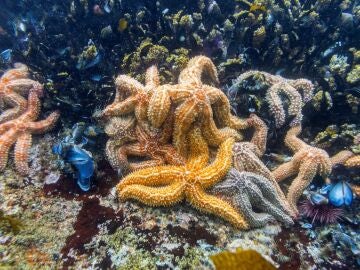
Yes one starfish If you were wearing pants, where would you put them? It may seem like a strange question, but, beyond the familiar – and fictitious – image of Patrick, SpongeBob’s inseparable friend, that may come to mind, the truth is that scientists have been asking questions about the strange body arrangement of these echinoderms: what is the head of a starfish? Does he have it?
For centuries, naturalists have speculated about what might constitute the head of a starfish, since their unusual body composition could lead one to think that they do not have any. However, now a study published in the scientific journal ‘Nature‘ suggests that, far from being headless, over evolutionary time starfish lose their bodies and they become just a head.
The research, carried out by Stanford and Berkeley Universities, led by Chan Zuckerberg Biohub San Francisco Investigators, has found the genetic signatures associated with head development in almost all parts of starfish juveniles, while the expression of genes encoding an animal’s torso and tail sections were missing.
In another surprising finding, the team has discovered molecular signatures typically associated with the frontal portion of the head in the middle of each arm of the starfish and that those signatures increasingly moved progressively towards the back of the ends of the arms. Thus, the study suggests that, far from being headless, over evolutionary time, starfish They lose their bodies and become just a head.
“It’s as if the starfish It is completely trunkless and is best described as simply a head that moves along the sea floor,” said Laurent Formery, Biohub academic and main author of the new study. According to this expert, “it is not at all what scientists have assumed about these animals.”
The mystery of the head of the starfish
Over the centuries, the body arrangement of starfish has challenged scientists’ understanding of animal evolution. Instead of showing a bilateral symmetryadult starfish and related echinoderms such as sea urchins, have an axis of symmetry without a defined head or tail.
Some scientists have proposed that in sea stars, the axis from head to tail could extend from the animal’s back to the area under the bellywhile others maintain that each of the five arms corresponds to a copy of the axis conventional from head to tail. Efforts to confirm these hypotheses have faced challenges, largely because methods to detect gene expression do not work well in the tissue of small starfish.
Marine biologist Christopher Lowe, from Stanford University and one of the co-authors of the study, and a group of scientists have tried to provide genetic information to establish the genetic activity by starfish Developing.
Thanks to a process called high fidelity sequencing To obtain precise data from DNA traces the size of an intact gene, making the process much faster and cheaper, the researchers were able to sequence the genomes of starfish and employ an approach called spatial transcriptomics. In this way, they were able to see which starfish genes were active in precise locations in the organism.
According to Formery, the results obtained suggest “that echinoderms, and sea stars in particular, have the most dramatic example of uncoupling of head and trunk regions of which we have evidence today.” The expert added that some ancestors of sea stars preserved in fossils seem to have had a trunk, which “opens up a lot of new questions that we are now beginning to explore.”
Source: Lasexta
Ricardo is a renowned author and journalist, known for his exceptional writing on top-news stories. He currently works as a writer at the 247 News Agency, where he is known for his ability to deliver breaking news and insightful analysis on the most pressing issues of the day.












